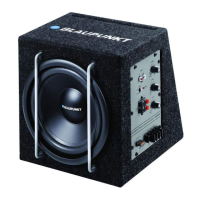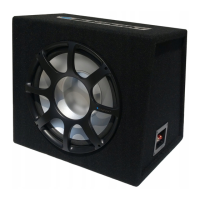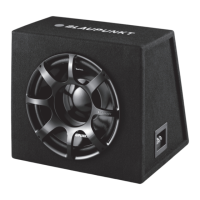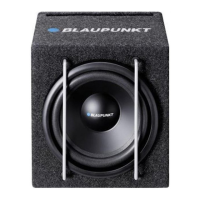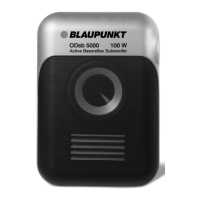GTbSA
USA
Please read these operating instructions before using
the
equipment for
the
first time.
Safety
Notes
Please
observe the
following
safety notes during the instal-
lation and connection.
- Disconnect the negative
terminal
of
the
battery before
carrying
out
installation
and connection work.
-
Observe
the
vehicle
manufacturer's safety instructions
(regarding airbags,
alarm
systems,
trip
computers,
vehicle immobilisers).
- When you drill holes, ensure
that
you
do
not
damage any
vehicle
components.
- The cross sections
of
the
positive and negative cables
must
not
be
less
than
1.5
mm
2
(A.W.G.
16).
-
An
incorrect
installation
can
result in malfunctions
of
the
electronic
vehicle
systems
or
your car sound system.
Installation
and connection instructions
With respect
to
accident safety, the
GTb
8 A
must be secured in a professional way.
When selecting
the
installation location,
select a
dry
location
that
offers sufficient air
circulation for cooling
the
amplifier.
The
GTb
8 A must
not
be
installed on rear
shelves, rear
seats
or other locations that
are
open
to
the front.
The amplifier power
cable
must be fitted
with
a fuse no more
than 30
em
from the battery
to
protect
the
vehicle
battery in
case
of
a short circuit between power amplifier and battery.
The fuse
of
the amplifier protects
only
the
amplifier,
not
the
vehicle
battery.
Switching
on/off
One
of
the
special
features
of
the
GTb
8 A
is
its
automatic
switch-on.
The subwoofer box automatically switches on
if
a music
signal
is
received.
·
If
there
is
no
music signal
for more than
60
seconds, the
GTb
8 A
automatically
switches off.
·
Connection
{see
page
27
I
Fig. 1)
Connection
®
is
connected
to
the
positive
pole
of
the
battery and connection
0
to
negative
vehicle ground. The
control
of
the
GTb
8 A
should ideally
be a two-channel con-
trol,
either via the preamplifier outputs
or
the loudspeaker
outputs
of
the car sound system. A
control solely
via the right
or
left channel
is
also possible since the low-frequency por-
tion
of
the music
is
generally
identical on
both
channels.
The preamplifier outputs are connected
to
the
cinch
(RCA)
sockets
@
of
the
subwoofer
box
via a
shielded
sound
cable.
With
control
via the loudspeaker outputs, the
input
connec-
tions
of
pos.
®I®
are
fed
to
the
closest
loudspeaker cables
(front or
rear)
on the
left
and right. They are separated and
26
I
connected
to
the
input
connections. The polarity
of
the
+
or-
connections must be observed. Bridge
output
stages
(BTL)
can
also
be connected directly
without
an
additional
adapter.
TIM
function:
For car sound systems
with
activated
TIM
function,
the
GTb
8 A must be
controlled
via
the
loudspeaker
outputs
of
the
car sound system and
not
via the
RCA
inputs
(see
page
27
I
Fig.
1
of
the
operating instructions).
CD
Upper
cut-off
frequency
®
Phase
position
®
Input
sensitivity
0
Connector cable
®
Right loudspeaker
input
®
Left loudspeaker
input
0
-Ground
®
+Battery
®
7.5
A fuse
@)
Status
display
(Power)
®
Preamplifier inputs
Settings
The
following control
setting
is
recommended
as
basic set-
ting
before
putting
the
device
into
operation: Sensitivity
(gain)
Pos.
®to
minimum, phase
Pos.
®to
0°,
filter
(cross-
over)
Pos.
CD
to
approx. 80
Hz.
Switch on the device and
select
a
musical
piece
with
distinctive
bass
playback.
Increase
the
volume
of
your stereo system
to
the
desired
volume level.
Now
slowly
increase
the
gain
control®
until
you can hear a clear
amplification
of
the
bass
level.
Next,
use
the crossover
control
CD
to
select
a
filter
setting that provides
a well-contoured
bass.
You
may have
to
alternately
optimise
the gain
control
setting®
and the filter
setting
(D.
A droning
bass
with
excessive volume
requires a filter
setting
with
a
low
frequency.
The phase switch must be set
so
that
the
bass
is
integrated
into
the
acoustic pattern
as
best
as
possible and
not
recog-
nisable
as
an
individual source.
Also
check your settings
of
the
GTb
8 A
with
the
bass
control
fully open and,
if
necessary,
with
activated loudness. An
overloading
of
the
subwoofer box by selecting
an
excessive
amplification
(pos.
G))
results
in a distorted playback and
can
damage the loudspeaker.
Recycling and disposal
~
Please
use
the
return and
collection systems
avail-
A
able
to
dispose
of
the product.
-
Subject
to
changes!

